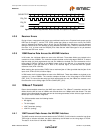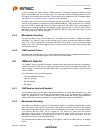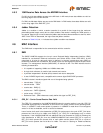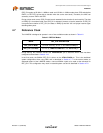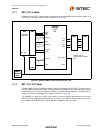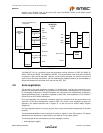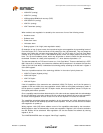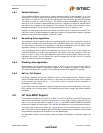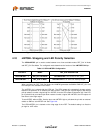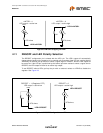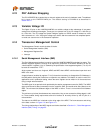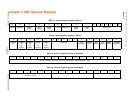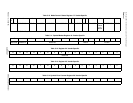
Small Footprint RMII 10/100 Ethernet Transceiver with HP Auto-MDIX Support
Datasheet
SMSC LAN8720/LAN8720i 31 Revision 1.0 (05-28-09)
DATASHEET
4.8.1 Parallel Detection
If the LAN8720/LAN8720i is connected to a device lacking the ability to auto-negotiate (i.e. no FLPs
are detected), it is able to determine the speed of the link based on either 100M MLT-3 symbols or
10M Normal Link Pulses. In this case the link is presumed to be Half Duplex per the IEEE standard.
This ability is known as “Parallel Detection.” This feature ensures interoperability with legacy link
partners. If a link is formed via parallel detection, then bit 0 in register 6 is cleared to indicate that the
Link Partner is not capable of auto-negotiation. The controller has access to this information via the
management interface. If a fault occurs during parallel detection, bit 4 of register 6 is set.
Register 5 is used to store the Link Partner Ability information, which is coded in the received FLPs.
If the Link Partner is not auto-negotiation capable, then register 5 is updated after completion of parallel
detection to reflect the speed capability of the Link Partner.
4.8.2 Re-starting Auto-negotiation
Auto-negotiation can be re-started at any time by setting register 0, bit 9. Auto-negotiation will also re-
start if the link is broken at any time. A broken link is caused by signal loss. This may occur because
of a cable break, or because of an interruption in the signal transmitted by the Link Partner. Auto-
negotiation resumes in an attempt to determine the new link configuration.
If the management entity re-starts Auto-negotiation by writing to bit 9 of the control register, the
LAN8720/LAN8720i will respond by stopping all transmission/receiving operations. Once the
break_link_timer is done, in the Auto-negotiation state-machine (approximately 1200ms) the auto-
negotiation will re-start. The Link Partner will have also dropped the link due to lack of a received
signal, so it too will resume auto-negotiation.
4.8.3 Disabling Auto-negotiation
Auto-negotiation can be disabled by setting register 0, bit 12 to zero. The device will then force its
speed of operation to reflect the information in register 0, bit 13 (speed) and register 0, bit 8 (duplex).
The speed and duplex bits in register 0 should be ignored when auto-negotiation is enabled.
4.8.4 Half vs. Full Duplex
Half Duplex operation relies on the CSMA/CD (Carrier Sense Multiple Access / Collision Detect)
protocol to handle network traffic and collisions. In this mode, the carrier sense signal, CRS, responds
to both transmit and receive activity. In this mode, If data is received while the transceiver is
transmitting, a collision results.
In Full Duplex mode, the transceiver is able to transmit and receive data simultaneously. In this mode,
CRS responds only to receive activity. The CSMA/CD protocol does not apply and collision detection
is disabled.
4.9 HP Auto-MDIX Support
HP Auto-MDIX facilitates the use of CAT-3 (10 Base-T) or CAT-5 (100 Base-T) media UTP interconnect
cable without consideration of interface wiring scheme. If a user plugs in either a direct connect LAN
cable, or a cross-over patch cable, as shown in Figure 4.7, the SMSC LAN8720/LAN8720i Auto-MDIX
transceiver is capable of configuring the TXP/TXN and RXP/RXN pins for correct transceiver operation.
The internal logic of the device detects the TX and RX pins of the connecting device. Since the RX
and TX line pairs are interchangeable, special PCB design considerations are needed to accommodate
the symmetrical magnetics and termination of an Auto-MDIX design.
The Auto-MDIX function can be disabled using the Special Control/Status Indications register (bit
27.15).



